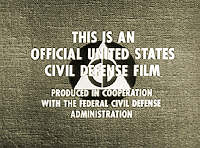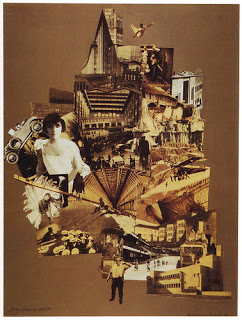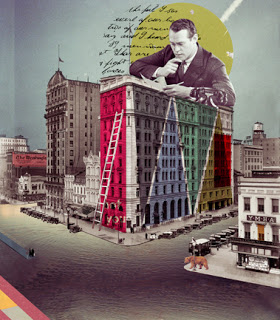
Oddball Films presents Urban Blight: Stress and the City, a program of vintage cartoons, short films, documentaries and propaganda about the rise of the American city and the environmental, social, and political ramifications thereafter. The animated Boomsville (1960s) chronicles the pillaging of native lands to build a metropolis. Eli Wallach stars as a New York City postman who's so fed up with the impersonal bureaucratic city, he hatches a devilish revenge plot in The Dehumanizing City... and Hymie Schultz (1967). Pollution (1969) features a hilariously disturbing montage set to Tom Lehrer's tragicomedic ditty. The mini-doc Altered Environments (1971) pits the city against the 'burbs and asks you where'd you rather live. The classic propaganda-scare film Our Cities Must Fight (1951) urges people to stay in the cities during wartime; after all, the nuclear contamination will dissipate after a day or two. In John and Faith Hubley's animation Urbanissimo (1966), the city grows a pair of legs and goes on a rampage of destruction. Designers Ray and Charles Eames chart the rise of the city coinciding with the rise of photography in the beautifully crafted Image of the City (1973). Jim Hens@n's Time Piece (1965) stars Hens@n himself, as a man literally sickened by the hectic pace of the urban rat-race. And because we all need a glimmer of hope in this bustling, chaotic, polluted impersonal town, the World Health Organization brings us Little Man-Big City (1968), a charming cartoon from Budapest with some interesting ideas on fixing society's ills.

Featuring:
Boomsville (Color, 1960s, NFBC)
Presents an animated overview of the growth of cities showing what man has done to his environment, from the explorer first spotting land to man reaching the moon. Recreates, without a single word, man’s interaction with his surroundings, tracing, step by step the process by which man took a virgin land and made of it a frantic congested ‘boomsville.’

Cut from the darkly comedic feature film, The Tiger Makes Out, (not available on VHS or DVD) starring Eli Wallach and Anne Jackson. Waking up one morning to the all too familiar frustrations and callous impersonality of big city life a mailman decides to fight back. He will be a one man army against complex bureaucratic machinery, anonymous no longer, taken advantage of no further. Nobody knows who he is, or cares. His co-workers superficially acknowledge him, and the citizens whom he serves see him only in terms of his function. The particular day starts off gloriously when the leg of his neighbor’s wife comes crashing through his ceiling, and our hero tries without success to get his landlady to make repairs. He then tackles the Housing Authority, where equally thwarted clerks treat him like a number. But today our hero refuses to be assigned any old place - he wants to be heard, at once! The bureaucracy proves more stubborn than he. Defeated and helpless, one individual lost among many, his angry campaign only led to more frustration.

From the people who brought you Duck and Cover comes this classic scare-propaganda piece that trades on our addiction to urbanism. Thinking of heading for the hills when the bomb drops? Think again. That's tantamount to treason, and in the Army you'd be court-martialed! This film aims to guilt and shame you into sticking around to help defend your hometown and rebuild its infrastructure. And after all, nuclear contamination will dissipate after a day or two.

Pollution (Color, 1969)
Brilliant song-satirist Tom Lehrer touches upon one of the city's largest environmental problems; Pollution. His hilarious song is used over a disturbing montage of archival footage, for one jazzy political statement!

Image of the City (Color, 1973, Charles and Ray Eames)
Shows how urban problems such as ethnic housing patterns and crowd estimations can be measured through photography-related techniques. Portrays the use of multi-brand cameras, radar images, computer-generated graphics, satellite observations and thermograms.
Altered Environment-An Inquiry Into the Growths of American Cities (Color, 1971)
Focuses on the environmental destruction that results from urban sprawl and analyzes factors that need to be considered in the design of cities. Asks questions concerning the advantages and disadvantages of living in the city and of living in the suberbs. Explores the problems caused by lack of adequate planning.

Little Man-Big City (Color, 1968)
A World Health Organization endorsed animation from Budapest, dramatizating of the effects of poor city planning, haphazard design, and inadequate health controls on the average urban dweller, and demonstrates the effect that one man can have on his chaotic urban environment. Designed and directed by, Gyula Macskassy and Gyorgy Varnai.

Time Piece (Color, 1965, Jim Hens@n)
This Oscar-nominated live-action short from M*ppets creator Jim H*nson is a rare treat, perhaps just for adults. Starring the young H*nson himself, a hospitalized man is sent through the ringer in this absurd commentary on modernity lost to the harried city around him, money, sex, food, industry, and most of all, time. Drawing on his prowess as puppeteer, H*nson crafts this surreal, racy, quick-cutting gem. The percussion is by swing and bop drummer Ed Shaughnessy (who also appears) and was recorded by the legendary Blue Note Records engineer Rudy Van Gelder.
For the Early Birds:
Wild Green Things in the City (Color, 1971)
Little Mona's afternoon in the countryside inspires her to create a rooftop refuge of greenery in her inner-city world. Although it is reminiscent of THE RED BALLOON in its dialogue-free style and urban setting, Wild Green Things in the City's young heroine is a not content to merely dream a better world for herself.
Buffy, The Bored Raccoon (1982)
The story of Buffy, a raccoon who is bored with the forest and river. Shows how Buffy, looking for excitement, goes to a farm only to be rejected by the animals there, and then moves on to the city. Describes some of the unpleasant aspects of Los Angeles city life that help Buffy appreciate that there is no place like home.




